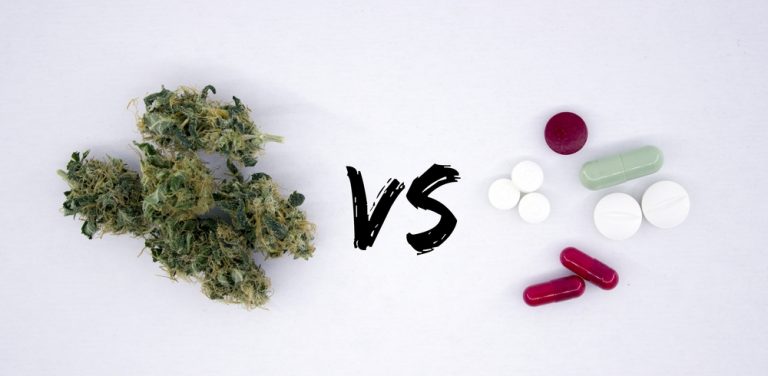A Friend Indeed? How Cannabis Can Help You Kick Other Bad Habits

Cannabis has been having a good couple of years. The one thing no one could envision – the complete legalization of recreational marijuana (in some states) – through the paranoia-soaked fog of the War on Drugs years is now as clear a reality as the sun rising over Puget Sound.
With legalization has come a deluge of new companies that have turned cannabis, in all its varied forms, into just another consumer product, bought like you would buy a pack of cigarettes or a can of beer.
And running just parallel to cannabis’ legislative successes is its growing acceptance as a legitimate treatment option for various conditions among the medical and scientific communities.
Study after study has demonstrated the usefulness of cannabis, its leaf and other forms like oil and edibles included, in everything from pain management, to treating muscle spasms and nausea.
Two recent studies have only added to the already extensive body of work to show why cannabis is a worthy alternative to more traditional, pharmacological therapies for the treatment of various mental and physical disorders.
One study, published in the International Journal of Drug Policy, found that a group of Canadian respondents, in many cases, substituted other, more habit-forming substances like prescription opioids and antidepressants, for marijuana to treat their conditions. The study was done to gauge the effectiveness of a new drug policy put in place just a few years ago.
The second study suggests a potential use for vaping cannabis as a harm reduction therapy for the cessation of tobacco use. The study explores the close relationship between cannabis and tobacco consumption and how the vaping of marijuana, (without tobacco, without combustion), can help disassociate the effects of nicotine from the effects of cannabis.
The Many Faces of Cannabis

Marijuana has been legal for medical use in Canada since 2001. In 2014, a change to the law was introduced that would allow for the expansion of the number of licensed marijuana growers and cultivators.
A survey was done of the patients who had used the new multi-producer system to measure their satisfaction and use patterns. All the patients in the study had medical marijuana licenses and, as such, meant they suffered from afflictions both mental and physical.
The most prominent finding of the survey was the 63% of respondents who had substituted prescription drugs for marijuana; prescription drugs, in this case, broken down between painkillers (30%), benzodiazepines (16%) and antidepressants (12%).
Cannabis substitution also occurred in cases where medical marijuana had substituted the regular use of alcohol (25%) and tobacco (12%). The study authors felt that these findings not only supported previous research but they also shed light on the specific conditions that marijuana helps treat as well as the particular medicines it replaces.
A somber counterweight to the study’s enthusiastic findings was that many of those surveyed, despite having their permissions, still relied on illegal distributors to obtain supplies of marijuana.
In addition to the fact that despite being medically approved to receive marijuana as a treatment, most users (close to 55%) also had to pay fees to be granted a medical marijuana pass, this shows that, as the authors suggest, more improvements are needed to the system.
A Diverging Path

Seeing as marijuana and tobacco are the most widely used substances in the world, it only makes sense to study how their complex chemistries impact one another. A group of European researchers has released their findings on how marijuana use affects a user’s tobacco use and vice-versa.
The study also made a case for vaping marijuana – where the plant is heated in an electrical device to produce a vapor stream, inhaled by the user – as a potential method for aiding in the cessation of both tobacco and marijuana consumption. While the study does not betray any biased, pro-marijuana sentiment (quite the opposite actually), it does note the importance of considering cannabis in discussions on smoking cessation practices.
The survey queried respondents on their marijuana smoking habits, specifically how often they mixed tobacco into their marijuana spliffs or joints. Europe saw the highest percentage of smokers, between 70% and 90%, who admitted to regularly blending their marijuana with tobacco.
The practice of mixing tobacco and marijuana was less prevalent, however, in Canada and the United States, 16%, and 4% respectively than in Europe. The researchers then discovered that a large number of these no-mix smokers had started vaping cannabis, rather than traditionally smoking it.
The study then makes the jump to arguing for vaping cannabis as a method to wean marijuana users off of marijuana, similar to how vaping e-cigarettes help smokers quit tobacco and, eventually, nicotine, altogether.
The authors built upon research that shows many marijuana smokers become addicted to nicotine because their joints are rolled with tobacco inside, which then makes it more challenging to quit both.
Since vaping offers users the possibility of receiving doses of either nicotine or THC in a safer, non-combustible format, the researchers argued, it must be considered a worthwhile treatment option for people looking to curb smoking both tobacco and marijuana.
More Questions than Answers
Despite the similarities between these two seemingly vindicating studies, there are still some differences in their conclusions, as well as their intentions.
The Canadian study, which was geared more toward pointing out the inefficiencies of the distribution system, discovered significant evidence regarding how marijuana can be used as a substitute drug to treat many different ailments.
The European study took the standpoint of trying to curb marijuana consumption altogether, along with tobacco use; “dual-abstinence” in their words, “is an ideal outcome from a health perspective.” The European paper did not issue scientific findings, more than making the recommendation that vaping marijuana be considered a possible smoking cessation tool.
Either way, what the two studies do show is a heightened interest in gathering evidence, but also initiating these scientific studies in the first place, of marijuana’s numerous health and psychological effects.
There is, no doubt, a mountain of evidence yet to be observed and proven on marijuana’s healing properties but these two studies seem to demonstrate that progress is being made.
Sources
https://www.addiction-ssa.org/commentary/cannabis-addiction-dont-forget-about-tobacco


Comments
Leave a comment